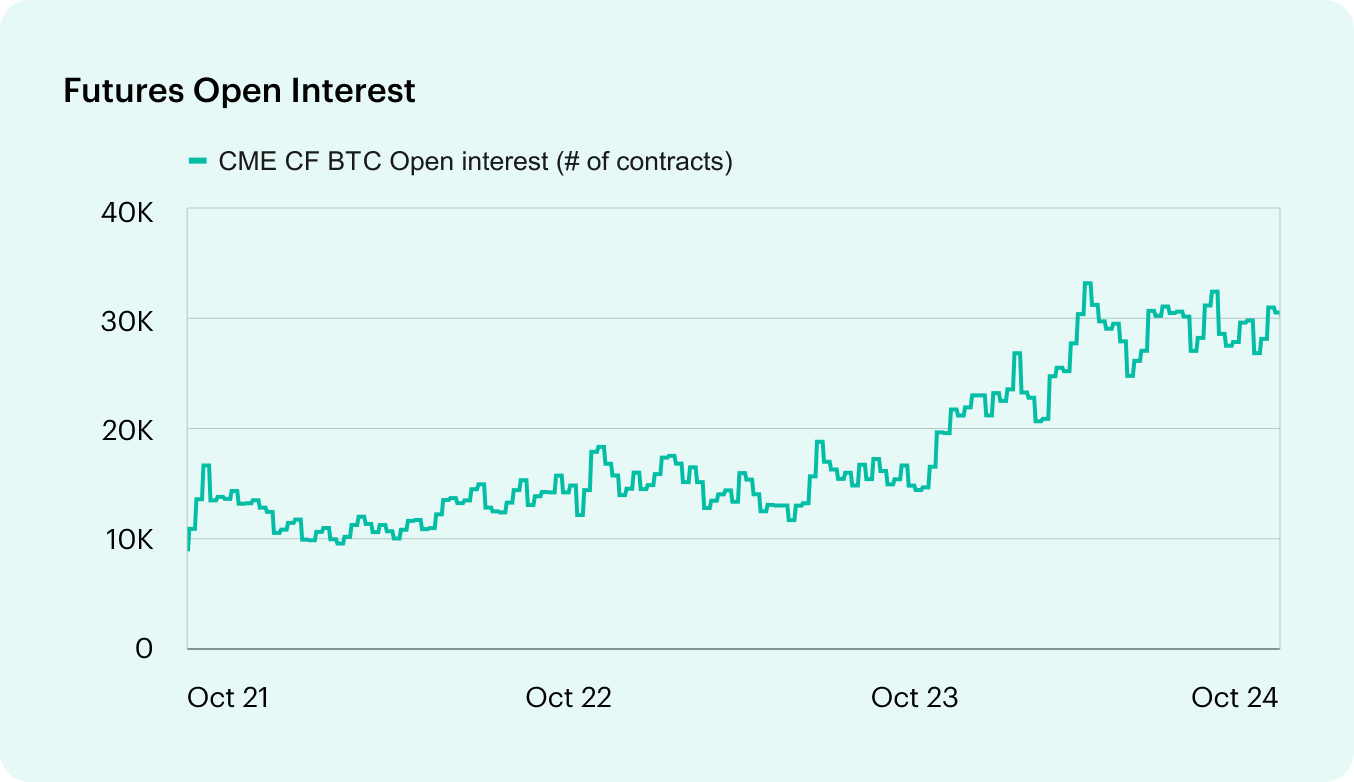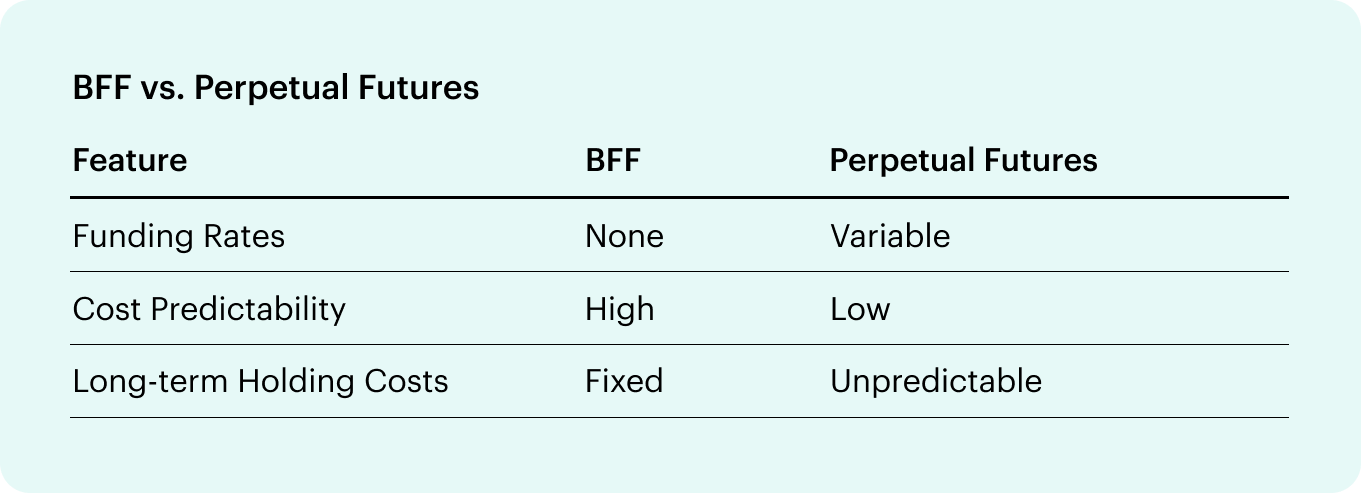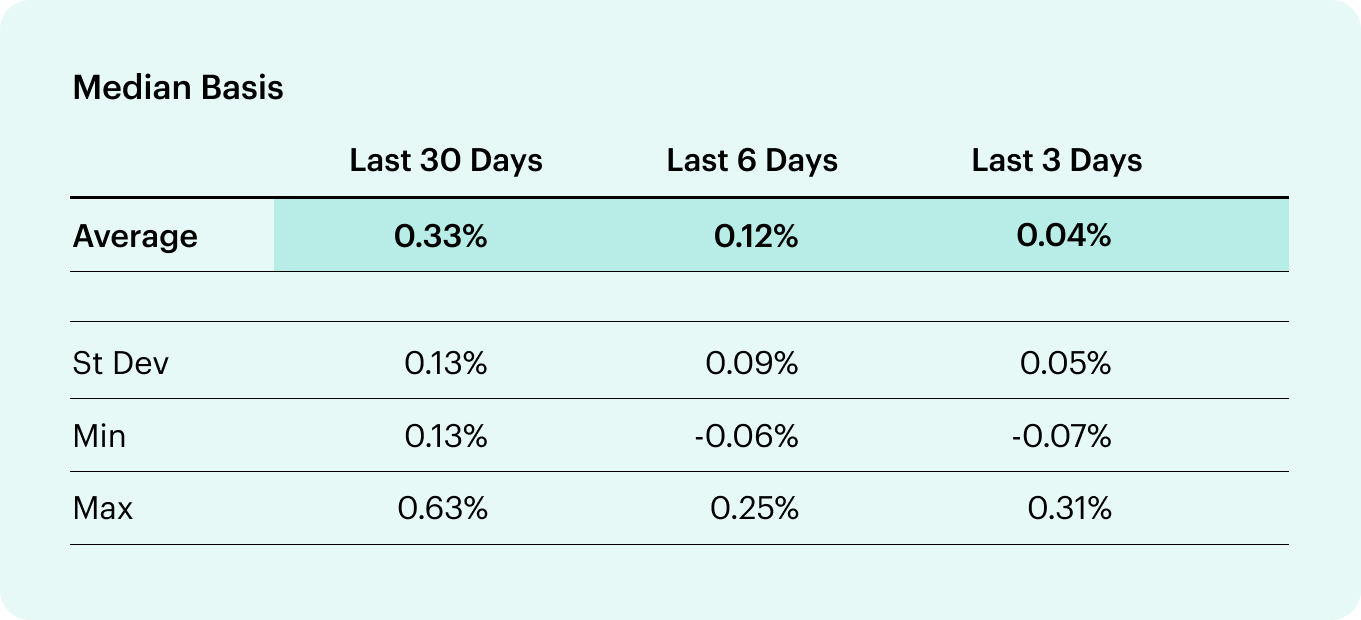Oct 11, 2024
Democratizing Institutional-Grade Derivatives through Bitcoin Friday Futures
The successful launch of CME's Bitcoin Friday Futures (BFF) marks the introduction of a groundbreaking instrument, offering a unique combination of retail accessibility and institutional-grade pricing within a regulated framework—something the market has never seen before. As the leading crypto index provider, CF Benchmarks stands at the forefront of this development, with our Bitcoin Reference Rate - New York variant (BRRNY) playing a crucial role in the pricing of the latest Bitcoin financial products.
In this analysis, we'll explore why BFF, underpinned by a robust benchmark like the BRRNY, represents a novel and viable alternative when compared to traditional perpetual futures. We'll delve into the intricacies of both products, highlighting how BFF addresses the limitations of perpetual futures and paves the way for a more mature, efficient, and accessible Bitcoin derivatives market.
Understanding the Retail Derivatives Landscape: BFF & Perpetual Futures
Before we dive into the specifics of BFF and perpetual futures, it's crucial to understand the context of the Bitcoin derivatives market. The demand for regulated bitcoin derivatives has grown exponentially in recent years, offering traders and investors various ways to gain exposure to Bitcoin price movements without necessarily owning the underlying asset. These instruments have played a significant role in increasing market liquidity, improving price discovery, and providing hedging opportunities. However, not all derivatives are created equal, and the introduction of BFF marks another leap forward in the evolution of these financial products.

The BFF Advantage: Institutionally Aligned, with Retail in Mind
BFF contracts offer a unique blend of institutional quality with retail accessibility, a combination that has been largely absent in the cryptocurrency derivatives market until now. Let's break down the key features that make BFF stand out:
- Smaller Contract Size: With a contract size of 0.02 BTC, BFF democratizes access to sophisticated Bitcoin trading instruments. This smaller size allows retail traders to participate with lower capital requirements, opening up institutional-grade products to a broader audience.
- Lower Margin Requirements: BFF's design includes lower margin requirements compared to traditional futures contracts. This feature not only reduces the barrier to entry for smaller traders but also allows for more efficient capital utilization across the board.
- CF Benchmarks' BRRNY Foundation: At the core of BFF's integrity is its use of the Bitcoin Reference Rate - New York variant (BRRNY) provided by CF Benchmarks. This regulated benchmark ensures reliable and transparent pricing, bridging the gap between institutional requirements for robust price discovery and the need for accessibility in retail markets. These weekly futures contracts will settle each Friday at 4:00 p.m. New York time, based on this respective reference rate.
The combination of these features creates a product that can cater to both institutional investors seeking a regulated, high-quality Bitcoin futures product and retail traders looking for professional-grade tools to execute their strategies.

Funding Rates in Perpetual Futures: A Double-Edged Sword
Perpetual futures use a funding rate mechanism to ensure the futures price remains close to the underlying asset's spot price. This rate is calculated periodically and involves payments between long and short position holders based on market conditions.
Traders on the overcrowded side of the market (determined by the difference between the perpetual future's price and the spot price) pay a funding fee to traders on the opposite side. This creates an economic incentive to balance long and short positions and maintain price alignment. Historically, perpetual funding rates on Bitcoin tend to be positive, reflecting a general market bias where long positions are more prevalent than short ones. However, this positive funding rate comes at a cost to the long futures holder, as they are required to make regular payments to short holders to maintain their position. This cost, while relatively small in each payment cycle, can accumulate over time, reducing the overall profitability of holding a long position in a rising market.
Funding rates can fluctuate wildly, especially during periods of high volatility or market imbalance. These fluctuations introduce unpredictable costs and risks for traders, potentially forcing premature position closures and exacerbating market moves.

The BFF Solution: Predictability & Stability
BFF eliminates the need for funding rates by having a fixed expiry date, offering a more predictable trading environment. This structural difference from perpetual futures means that BFF contracts naturally converge with the spot price as they approach expiration, without the need for an ongoing funding mechanism. This design aligns BFF more closely with traditional futures markets, making it more familiar and accessible to a wider range of traders and institutions.

The removal of funding rates provides predictable costs, allowing traders to accurately forecast their holding costs. The shorter duration of BFF contracts typically results in low basis and predictable convergence. This cost predictability is particularly beneficial for risk management and strategy planning. Traders can more easily calculate their potential profits or losses without the variable of fluctuating funding rates. The low basis (difference between futures and spot price) in shorter-term contracts means that the cost of rolling positions forward is often lower and more stable compared to longer-dated futures or perpetual contracts.


The absence of funding rates in BFF simplifies trading strategies, especially for short-term traders, and reduces the risk of market manipulation that can occur with funding rates in perpetual futures. Without funding rates, traders can focus solely on price action and their market view, rather than factoring in complex funding calculations. This simplification is particularly advantageous for algorithmic trading and quantitative strategies. Additionally, the fixed expiry eliminates the potential for malicious actors to manipulate funding rates for their benefit, a risk that exists in perpetual futures markets where large players may sometimes influence funding rates to their advantage.
Optimized for Short-Term Trading
The weekly expiry structure of BFF provides significant advantages for short-term traders:
- Minimized Basis Risk: The shorter duration between contract inception and expiry reduces the potential for significant divergence between futures and spot prices.
- Lower Roll Costs: Traders can maintain exposure beyond a single contract's expiry by rolling positions more frequently and at potentially lower costs compared to monthly or quarterly futures. This feature benefits long-term strategies and can improve profitability for continuous market exposure.
- Precise Timing: Weekly expirations allow traders to align their positions more closely with specific events or market expectations. This granularity enables more targeted trading strategies, particularly for event-driven traders or those capitalizing on short-term market movements.
This optimization for short-term trading, combined with the elimination of funding rates, offers a more efficient vehicle for those looking to capitalize on short-term market movements without the ongoing costs associated with perpetual futures.
Enhanced Market Integrity through Robust Benchmarks
CF Benchmarks' BRRNY, the foundation for BFF settlement, significantly bolsters market integrity in the cryptocurrency space. As a regulated benchmark, it offers the oversight and reliability crucial for institutional adoption. Its alignment with spot ETF NAV calculations creates a robust link between futures and the expanding Bitcoin ETF ecosystem. The transparent methodology of BRRNY enhances market clarity and substantially reduces manipulation risks, fostering trader confidence and paving the way for increased institutional participation.

In today's climate of intense crypto market scrutiny, BFF's regulatory alignment provides distinct advantages. Trading on the Chicago Mercantile Exchange, a premier and regulated platform, BFF benefits from a clear legal framework and reduced counterparty risk. This regulatory clarity is particularly attractive to institutional investors, potentially driving broader adoption of Bitcoin derivatives in traditional finance.
Many perpetual futures operate in regulatory gray areas, exposing traders to legal and operational risks. The lack of robust oversight leaves users vulnerable to unfair practices or exchange insolvencies. As regulations evolve, access to these products may face restrictions. Additionally, the dispersion of perpetual futures across multiple platforms can fragment liquidity, leading to wider spreads and increased slippage.
The regulatory ambiguity and unique features of perpetual futures, such as funding rates, also present challenges for institutional participation. These factors complicate risk management processes and limit involvement from regulated entities, underscoring the potential advantages of more structured products like BFF in the evolving cryptocurrency derivatives landscape.
Conclusion
While perpetual futures have contributed significantly to the crypto derivatives market, BFF represents the next step in the evolution of crypto derivatives. Addressing key issues of perpetual futures and leveraging regulated benchmarks like CF Benchmarks' BRR-NY, BFF offers a more transparent and efficient way to trade Bitcoin. Its advantages, including cost efficiency, enhanced market integrity, and regulatory alignment, make it attractive for both institutional and retail traders.
As the cryptocurrency market integrates with traditional finance, products like BFF are expected to gain prominence, increasing liquidity and improving price discovery. For those seeking a more predictable and regulated environment, BFF presents a compelling alternative to perpetual futures, potentially playing a crucial role in Bitcoin's broader adoption in the global financial system.
The information contained within is for educational and informational purposes ONLY. It is not intended nor should it be considered an invitation or inducement to buy or sell any of the underlying instruments cited including but not limited to cryptoassets, financial instruments or any instruments that reference any index provided by CF Benchmarks Ltd. This communication is not intended to persuade or incite you to buy or sell security or securities noted within. Any commentary provided is the opinion of the author and should not be considered a personalised recommendation. Please contact your financial adviser or professional before making an investment decision.
Note: Some of the underlying instruments cited within this material may be restricted to certain customer categories in certain jurisdictions.

Ken Odeluga

CF Benchmarks

Gabriel Selby


